Pergolesi: Adriano in Siria
Giovanni Battista Pergolesi died at the age of 26 in 1736, yet he is still considered one of the most original and influential composers, despite only really being more popularly known for a couple of works, of which this isn't one. Adriano in Siria was premiered in 1734, and this performance was filmed in the theatre named after him in his home town of Jesi for the tercentenary celebrations of the composer's birth.
The libretto is by the Italian poet Pietro Antonio Domenico Trapassi, who was better known by his pseudonym, Metastasio, and is one which had already been set a couple of times before and a good few times since. The story is firmly down to earth, in that we don't have your actual classical gods and goddesses on stage battling with very human emotions, but an interpretation of the Roman emperor Hadrian and a fictional account of a victory against the King of Antioch, Osroa.
Hadrian (Adriano) is not made out to be a particularly pleasant individual, and the plot revolves around his love for Osroa's daughter, Emirena, despite being betrothed to the Roman noblewoman, Sabina. Emirena is herself intended for Farnaspe. Adriano is constantly cajoled into pressing further for Emirena's favours by his friend, Aquilio, but only because Aquilio is actually in love with Sabina.
So, the usual criss-cross of relationship crises that wouldn't be out of place in a 1970s theatrical farce, and it all ends with the expected grand gesture of forgiveness and humility by Adriano of course, and there would have been little surprise to the audiences of the day.
What also wouldn't have been a surprise to contemporary audiences was the inclusion of an Intermezzo - a completely separate dramatic work inserted in between the main acts of the larger opera. It was generally intended to act as a comic interlude which gave some relief from the seriousness of the main programme. It also tended to present more familiar characters to which the audience could relate, together with far more ribald and slapstick behaviour than would be seen in the lives of gods, kings and emperors.
Pergolesi was an expert at such Intermezzi, with the famous La Serva Padrona becoming more popular than the Opera Seria to which it was originally attached. In this production, the original intermezzo to Adriano has been resurrected.
Livietta e Tracollo is a comedic two-part story that revolves around cross-dressing, romantic entrapment, proposal, rejection and finally, reconciliation. The characters emerge from the audience and all the action takes place in front of the curtain. In the pit, there is a much smaller band, all of whom are on their feet (well, those for whom their instruments will allow) and the whole thing feels far less 'distant' than many operatic production will do when you're a long way off from the stage - which is exactly how it should be.
The music to Livietta... is quite simple, yet full of energy and carried across brilliantly by the band and the two main characters (Monica Bacelli and Carlo Lepore), who mingle with the audience in best pantomime tradition, and the whole thing is certainly a highlight of the disc.
The music to the main opera is altogether more surprising and fascinating. Even though Pergolesi tended to stick to much the same structure for his arias, in which the characters ruminate about their various inner turmoils, the musical invention is never in doubt. You would be forgiven if some was mistaken for early Mozart, especially in the use of instrumentation and it's obvious how much of an influence he had on later composers throughout the centuries (Stravinsky used at least one of the melodies in this work for 'Pulcinella'), despite dying so tragically early.
Ignacio García's direction and Zulima Memba Del Olmo's set design allows enough of the ancient world to be depicted (mainly using crumbling classical columns) without any of the details laid out in the original scene directions to get in the way of the unfolding drama. Costumes are fairly monochrome in general, yet are designed to allow flowing movement when required.
There is also a nice touch in the use of live birds on stage. One caged songbird, and one very well trained kestrel (?) who appears to be given free run of the theatre space. I probably shouldn't consider the female oboist who accompanies Lieto così tal volta in the first Act as part of this list, although she too is very well behaved and plays beautifully.
The Accademia Bizantina, directed from the keyboard by Ottavio Dantone, play superbly, with the tightest of ensemble work. If anything, the relative shallowness of the pit creates a bias towards the orchestral sound, but the stage mics pick everything else up in a fairly natural manner.
All the singers in this production are relatively new to me, yet everyone is fully versed in the techniques necessary to carry off Pergolesi's sometimes vicious vocal lines and still be able to produce some quite disarming detail, especially in the form of dramatic and well-controlled dynamic changes. Diction is also nigh-on perfect, which would certainly be a bonus for the Italian speaking audience.
It's difficult to pick on every highlight of the singing, however Annamaria dell'Oste (Farnaspe) si quite stunning in the aforementioned Lieto così tal volta, and Nicole Heaston (Sabina) has such a pure, yet piercing (in a good way) tone that you cannot help but want to see her in other roles as soon as possible.
Extras are a little thin on the ground, being the obligatory 'Cast Gallery' and a short contribution from Dantone on the music. This is quite interesting, but I would have loved to have had more information as to how it was decided which parts of the original work were kept (as I'm sure there are omissions judging by the timing of the work as a whole) and it would have been very useful to have had a track list in the booklet.
These minor moans aside, this is an excellent disc which leaves you wanting more of Pergolesi's operatic work brought back to life as I'm sure there's plenty of wonderful music to be rediscovered.
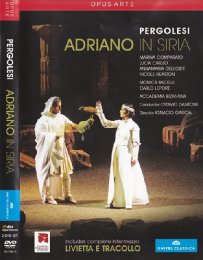

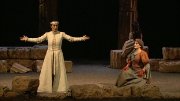
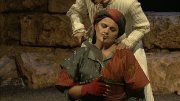
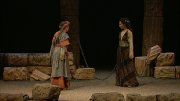


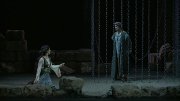
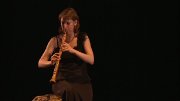
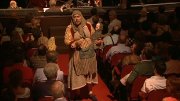


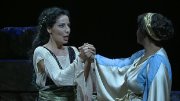
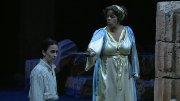
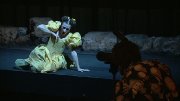
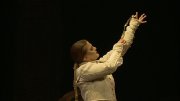
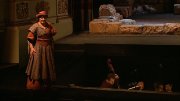

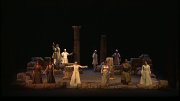






































Your Opinions and Comments
Be the first to post a comment!